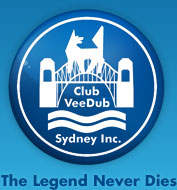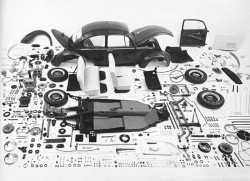VW Part Numbers
All Volkswagen spare parts have their own specific Volkswagen parts number. This is based on a logical, carefully thought-out numbering system that makes it easy to assign new numbers as well as recall old ones. It’s useful to know how the VW numbering system works when you are looking for that spare part for your VW.
The standard Volkswagen part numbering system applies to all Volkswagens, from the earliest air-cooled models to the present day. It also covers Audi spare parts.
Sometimes you might find a component that has a 9 or 10-digit number stamped onto the part itself. These are manufacturers’ numbers, and while it may be the same as the specified VW part number, it also might not be. It’s always best to refer to the Volkswagen parts catalogue (ETKA) for the correct Volkswagen parts number, and use that number for ordering.
The Volkswagen parts catalogue was once in produced in microfiche form, which VW dealers used with their microfiche viewers, and printed versions of the old microfiche catalogue (with exploded line drawings) are still used by some VW shops. Original VW microfiche packs and viewer machines are much sought after by VW collectors.
In 1989 Volkswagen AG introduced the modern ETKA (Elektronischer Teilekatalog) computer system in their official dealerships. These allow fast, powerful specific searches; secure connection to the central database at Wolfsburg; automatic daily updating; local customisation (language, pricing, taxes, etc); easy printing; and seamless integration with the dealers’ accounting and parts ordering system. Older versions on DVD (for Windows PCs) can be purchased on Ebay but may be 2-5 years out of date. For owners of older VWs this may not be a problem, but owners of new VWs will need to contact their Volkswagen dealer.
The Volkswagen part numbering system is made up of nine digits, divided into three groups of three digits, and almost always followed by a tenth ‘supplementary’ digit. We will look at each group of three digits in turn.
To use an example, a typical VW part number might be:
171 819 047A
We will use this random example of a VW spare part to show how the system works.
| Digit 1-3 | 171 | Model or Unit Code |
| Digit 4 | 8 | Main Group |
| Digit 5-6 | 19 | Subgroup |
| Digit 7-9 | 047 | Part Number |
| Digit 10 | A | Modification Code |
Model or Unit Code
171 819 047A
The model or unit code is the first three digits of the VW part number. The first two digits tell us which Volkswagen model (or ‘type’) the part or unit number was originally developed and used for. In this case, 17 is a VW Golf 1 (Type 17). For later model VWs the first two digits will match the vehicle’s two-digit model code from the VIN – such as ‘1K’ for a Golf 5 or ‘7H’ for a T5 Transporter. It is quite possible that the part or unit can also be used on other models; for example Type 3s and Beetles share numerous mechanical parts; these could have a 111 or a 311 prefix. Refer to the VW Model Types and the VIN Codes pages for more information on VW model types.
The third digit refers to Right or Left-hand Drive specific parts:
Odd Number = Left hand drive
Even Number = Right hand drive
Main Group
171 819 047A
The fourth digit tells us to which area of the vehicle the part belongs, according to the following key:
0 - Accessories
1 - Engine, Cooling, Clutch
2 - Fuel Tank, Exhaust, Heater, Ventilation
3 - Transmission
4 - Front Axle, Suspension, Steering, FWD differential
5 - Rear axle, Suspension, RWD differential
6 - Road wheels, Brakes
7 - Frame, Levers, Pedals, Cables
8 - Body, Interior
9 - Electrical equipment
In our example, our part number is a body part for a Golf 1.
Subgroup
171 819 047A
Each main group is then divided into a number of subgroups. As far as possible, the parts are arranged in the subgroups in numerical order on the basis of design-related considerations. The subgroup has no meaning unless it is combined with the main group.
In our example, the 819 category points us towards the heater mechanism.
A subgroup of ‘98’ indicates a repair kit. Thus, part number 311 698 191A is a brake repair kit for a Type 3.
Part Number
171 819 047A
The part number describes the part itself, and consists of three digits (000-999). The numbering is consecutive.
If the part can be used on both the left and right, the last digit is ODD. If the left-hand and right-hand parts differ – door handles, for example – this distinction is shown in the last digit. ODD = Left-hand part. EVEN = Right-hand part.
In our example, we have reached a unique part number for a Golf 1 Air Control.
Modification Index
171 819 047A
Modification of a part is indicated by the tenth, and possibly eleventh, digits of a part number.
The modification letter(s) mean that the part has undergone some changes. This might be because of a change of material, a change of supplier, or, most likely, a change or improvement in design.
Colour Code
431 819 794A 66W
The colour code serves to identify interior trim parts, and takes the form of a three-digit figure or three-digit character combination of figures and letters.
The groups of figures and letters always form a unit, and therefore have a meaning only when together.
Other Codes
Miscellaneous Parts are those with a Model Code unit of ‘L’, ‘M’ or a three-letter series beginning with ‘Z’. For example:
L 009 103
MPF 002 400
LKL 096 N00
ZAW 411 104
The parts covered by these codes are usually paints, adhesives, sealants, lubricants and fluids, as well as dealership equipment such as signs, badges, tools and even fiche readers and computers. Parts beginning with ‘ZVW’ are usually accessories.
Standard Parts consist of an ‘N’ followed by two three-digit groups, and an index character or two:
N 014 3953
N 900 50605
Similar To Standard Parts have a ‘900’ in the first group of three digits, as in the second example above. There are no differences with regard to the meanings of the individual groups.
These ‘N’ prefixed Standard Parts are the nuts, bolts, studs, screws, washers, clips, bulbs, nipples, clamps, pins and hoses that have no special application – you could use them anywhere.
Exchange Engines and Engine Parts can be spotted by a letter code following the part number in the same way as a modification code, but using V-Z instead of A. VW Exchange engines and parts were made in Australia until 1968, after which they were imported.
029 100 031Z
311 101 065HV
211 141 025AX
411 407 075Z
Domestic Accessories are parts made only for Australian VWs that were catalogued that way by VW Australia (this has not been done since the 1970s). They have a VA (Volkswagen Australia) prefix.
VA 045 400A
They cover everything from floor mats to tow bars, driving lamps, seat belts, radios, louvres, sports steering wheels, local air con, paint tins and mud flaps.
Australian VW Campmobile Parts are non VW-supplied parts used in ‘factory’ VW Campmobiles of the 1970s.
CMP 015 210A
This category of parts is for Australian-made ‘factory’ VW Campmobiles, which were converted by E.W. Sopru (Adelaide, Melbourne, Sydney) and sold new through VW dealerships in the 1970s. The ‘CMP’ indicates Campmobile parts, while the remaining digits follow the VW numbering system. These parts comprise all the components used in converting an empty Kombi into a finished Campmobile – furniture, roof, fridge, sink, stove, fittings, accessories etc.
DOR 041 505
Similarly, this category is for Australian-made Dormobile VW Campmobiles. These were English-style campers with side-opening hoods, made by Dormobile Pty Ltd of Canberra.

